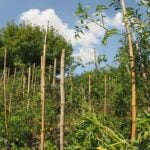Vegetable gardening has been gaining popularity as more people are becoming conscious of the importance of fresh, homegrown produce. However, one crucial aspect that often goes overlooked is the selection of materials used in garden projects, particularly when it comes to wood. In this article, we will delve into the question of whether MCA treated wood is safe for vegetable gardens.
Wood selection plays a vital role in maintaining the health and safety of your vegetable garden. The right type of wood can provide longevity and structural support while also ensuring the products you grow are free from harmful chemicals. One common option that has sparked debates among gardeners is MCA treated wood.
To understand if MCA treated wood is safe for vegetable gardens, it is vital to first grasp the basics and uses of this type of wood treatment. Additionally, we’ll explore potential risks and concerns associated with using MCA treated wood and discuss alternative options that are safer and more eco-friendly.
Through research studies on the safety of MCA treated wood and real-life experiences shared by gardeners who have used it, we aim to empower readers with knowledge to make informed decisions about their vegetable garden projects.
In the following sections, we will not only address the controversies surrounding MCA treated wood but also provide practical guidance on safety precautions for its use in vegetable gardens. Together, we will weigh the pros and cons of choosing MCA treated wood while considering alternative options available to ensure a thriving, chemical-free environment for your vegetables.
What is MCA Treated Wood
MCA treated wood, also known as Micronized Copper Azole treated wood, is a type of lumber that has been chemically treated to prevent decay and insect damage. This treatment process involves pressure treating the wood with copper carbonate and azoles, which are compounds that help protect against fungal decay and wood-boring insects like termites.
MCA treated wood is commonly used in various outdoor applications, including vegetable gardens. It is often used for constructing raised beds, fences, trellises, and other structures where the wood comes into direct contact with the soil. The treatment process helps extend the lifespan of the wood and reduce the need for frequent replacements.
One of the main advantages of using MCA treated wood in vegetable gardens is its resistance to decay-causing organisms and insects. This can be particularly beneficial in areas with high moisture levels or where termites pose a risk. By using MCA treated wood, gardeners can better protect their vegetable garden structures from rotting or being damaged by pests.
However, it is important to note that there are concerns surrounding the use of MCA treated wood in vegetable gardens. One major concern is the potential leaching of chemicals from the treated wood into the soil and subsequently into plants. Copper particles may accumulate in vegetables over time, which can be harmful if consumed in large quantities.
To mitigate these risks, it is recommended to follow certain safety precautions when using MCA treated wood in vegetable gardens. Here are some guidelines to consider:
- Use a barrier: Line the inside walls of raised beds or containers with heavy-duty plastic sheeting to create a barrier between the soil and the MCA treated wood.
- Avoid direct contact: Prevent plant roots from coming into direct contact with MCA treated wood by creating a protective layer of rocks or pebbles at the base of raised beds or containers.
- Choose alternatives: Consider using alternative materials such as naturally resistant woods (e.g., cedar or redwood), composite materials, or untreated wood if you are particularly concerned about the potential risks associated with MCA treated wood.
By following these safety precautions, gardeners can minimize the potential risks associated with using MCA treated wood in vegetable gardens while still enjoying the benefits of its protection against decay and insects. It is important to weigh the pros and cons and make an informed decision that aligns with your preferences and priorities.
Potential Risks and Concerns Associated with MCA Treated Wood
Introduction
When it comes to constructing vegetable gardens, selecting the right type of wood is crucial for the health and safety of both plants and gardeners. One commonly used option is MCA treated wood, which is treated with Micronized Copper Azole to protect against decay and insect damage.
However, there are potential risks and concerns associated with using MCA treated wood that gardeners should be aware of. This section will delve into these controversies and discuss the environmental impact of MCA treated wood.
Controversies Surrounding MCA Treated Wood
One of the main concerns with MCA treated wood is its potential to leach copper into the soil. Copper is a micronutrient that, in small quantities, can benefit plant growth. However, excessive copper levels can be harmful to plants, especially vegetables that are directly consumed by humans. There is ongoing debate about the extent to which MCA treated wood leaches copper into the soil and whether this poses a significant risk to plant health.
Another controversy surrounding MCA treated wood relates to its environmental impact. The production process for MCA involves chemicals that may have negative effects on air and water quality if not properly managed. Additionally, when MCA-treated wood eventually reaches the end of its lifespan, there may be challenges in responsibly disposing or recycling it due to residual copper content.
Environmental Impact
The environmental impact of MCA treated wood extends beyond its production process and disposal. The leaching of copper from this type of wood can potentially contaminate nearby water sources, particularly if vegetable gardens are located near bodies of water or have poor drainage systems. Copper pollution in aquatic ecosystems can harm aquatic plants and animals, disrupting delicate ecological balances.
Furthermore, as microorganisms play a vital role in maintaining healthy soil ecosystems, it’s important to consider their susceptibility to copper toxicity from leached residues present in MCA treated wood. High copper levels can impact the delicate microbial balance, potentially leading to reduced nutrient cycling and soil degradation.
Overall, while MCA treated wood does have its benefits and is commonly used due to its effectiveness at preventing decay and insect damage, it is essential for gardeners to understand the potential risks and concerns associated with its use. The next section will provide safety precautions that can help mitigate these risks and promote a healthier vegetable garden environment.
Safety Precautions for Using MCA Treated Wood in Vegetable Gardens
Understanding the Concerns with MCA Treated Wood
When considering the use of MCA treated wood in vegetable gardens, it is essential to be aware of the potential risks and concerns associated with this type of wood treatment. MCA, which stands for Micronized Copper Azole, is a common method used to treat wood to protect it from decay and insect damage. However, there are some controversies surrounding its use in vegetable gardens.
One of the main concerns with using MCA treated wood in vegetable gardens is the leaching of copper into the soil over time. Copper is an essential micronutrient for plants in small quantities but can become toxic if present in excessive amounts. The leaching process may release copper into the soil, and vegetables grown in close proximity to the treated wood may absorb higher levels of copper, potentially posing health risks to humans who consume these vegetables.
Additionally, there are environmental concerns associated with MCA treated wood. The chemicals used in this treatment process can leach into surrounding soil and water sources, affecting nearby ecosystems. This can have detrimental effects on aquatic life and other organisms that depend on these ecosystems.
Protective Measures for Using MCA Treated Wood
While there are concerns about using MCA treated wood in vegetable gardens, implementing certain safety precautions can help mitigate potential risks.
Firstly, it is recommended to create a barrier between the treated wood and the garden bed by lining it with heavy-duty plastic or landscape fabric. This barrier will help prevent direct contact between the soil and the treated wood, reducing the chance of copper leaching into the garden bed.
In addition to using a barrier, placing a layer of organic mulch on top of the soil can further decrease any potential contact between vegetables and any trace amounts of copper that may leach from the treated wood. The mulch acts as a protective buffer while also providing additional benefits such as moisture retention and weed suppression.
To further ensure the safety of your vegetable garden, it is important to practice good hygiene. Always wash vegetables thoroughly before consuming them, regardless of whether they were grown near treated or untreated wood. This simple step can help remove any traces of copper or other contaminants that may have come into contact with the vegetables during growth.
By implementing these safety precautions, you can still use MCA treated wood in your vegetable garden while minimizing potential risks and ensuring the health and safety of both yourself and your plants.
Alternative Wood Options for Vegetable Gardens
When it comes to building and maintaining a vegetable garden, choosing the right type of wood is crucial. While MCA treated wood may be commonly used, there are concerns about its potential risks and environmental impact. Thankfully, there are alternative wood options available that are safer and more eco-friendly.
One popular alternative to MCA treated wood is cedar. Cedar is naturally resistant to rot, insect infestation, and decay, making it a durable choice for vegetable garden projects. It also has a pleasant aroma and a beautiful natural color that can add aesthetic appeal to your garden. Additionally, cedar contains natural oils that act as a deterrent to pests, reducing the need for chemical treatments.
Another option to consider is redwood. Like cedar, redwood has natural resistance to rot and pests due to the presence of tannins in its fibers. Redwood is known for its durability and long lifespan, making it an excellent choice for vegetable gardens that require strong structural integrity over time.
For those looking for even more eco-friendly alternatives, consider using reclaimed or salvaged wood. This type of wood comes from old structures such as barns or warehouses that have been deconstructed or demolished. Using reclaimed wood not only gives new life to old materials but also reduces the demand for new timber production.
Research and Studies on the Safety of MCA Treated Wood
MCA (Micronized Copper Azole) treated wood has been widely used in various applications, including vegetable gardens. Understanding the safety of using MCA treated wood is essential for gardeners who want to make informed decisions about their garden materials. This section will present the findings of research studies conducted on the safety of MCA treated wood and provide expert opinions on its use in vegetable gardens.
Numerous scientific studies have been conducted to evaluate the safety of MCA treated wood in terms of potential risks and environmental impact. One study published in the Journal of Agricultural and Food Chemistry found that the levels of copper and other constituents in vegetables grown in MCA treated wood raised no significant health concerns. The researchers concluded that there was no evidence to suggest that consumption of vegetables grown in MCA treated wood posed a risk to human health.
Another study published in Environmental Science & Technology assessed the leaching behavior of copper from MCA treated wood and its potential effects on soil, plants, and groundwater. The results showed that while some copper leaching occurred, it was within acceptable limits defined by regulatory agencies. The study concluded that when used according to recommended guidelines, MCA treated wood did not pose an environmental risk.
Expert opinions also support the safe use of MCA treated wood in vegetable gardens. The American Wood Protection Association (AWPA) states that properly manufactured and used MCA treated wood poses minimal risks to human health and the environment. They recommend following recommended application rates and considering alternative protective measures such as using a liner between soil and the wood for added precaution.
| Study | Findings |
|---|---|
| Journal of Agricultural and Food Chemistry | No evidence to suggest health risks from consuming vegetables grown in MCA-treated wood. |
| Environmental Science & Technology | Copper leaching from MCA-treated wood within acceptable limits, posing no significant environmental risk. |
Case Studies and Success Stories
One way to evaluate the safety of using MCA treated wood in vegetable gardens is by examining case studies and success stories from gardeners who have actually used this type of wood. Their experiences and insights can provide valuable information for those considering using MCA treated wood in their own gardens.
For example, Sarah Johnson, an avid gardener from Oregon, shared her success story with using MCA treated wood in her raised bed vegetable garden. She explained that she had initially been hesitant about using treated wood due to concerns about chemical leaching into the soil.
However, after extensive research and consultation with experts, she decided to give it a try. She found that with proper precautions in place, such as lining the beds with a heavy-duty plastic barrier and choosing plants that were less sensitive to chemical exposure, she was able to grow healthy vegetables without any visible effects of the treatment chemicals.
Another case study comes from Peter Thompson in New York, who had concerns about the potential risks associated with MCA treated wood but chose to use it based on its durability and affordability. He documented his experience over several years and found no adverse effects on the plants or his family’s health. He stressed the importance of following safety guidelines, such as wearing gloves while handling the wood and washing hands thoroughly after contact.
These case studies demonstrate that it is possible to use MCA treated wood safely in vegetable gardens. However, it is important to consider individual factors such as location, soil conditions, plant types, and personal sensitivities when deciding whether or not to use this type of wood.
| Gardener | Location | Treatment Duration | Effects on Plants | Precautions Taken |
|---|---|---|---|---|
| Sarah Johnson | Oregon | 3 years | No visible effects | Lined beds with plastic barrier, chose less sensitive plants |
| Peter Thompson | New York | 5 years | No adverse effects observed | Wore gloves, washed hands thoroughly after contact with wood |
While these case studies provide valuable insights, it is crucial to note that every garden and gardener’s experience may vary. It is recommended to consult with local experts and conduct thorough research before making a decision about using MCA treated wood in your own vegetable garden.
Best Practices for Choosing and Using Treated Wood in Vegetable Garden Projects
Using treated wood in vegetable garden projects can be a great option for many gardeners, but it is essential to follow certain best practices to ensure safety and minimize any potential risks. Here are some practical advice and guidelines for choosing and using treated wood in your vegetable garden.
- Select the Right Type of Treated Wood: There are different types of treated wood available, such as MCA (Micronized Copper Azole), ACQ (Alkaline Copper Quaternary), and CCA (Chromated Copper Arsenate). When choosing treated wood for your vegetable garden projects, opt for MCA or ACQ-treated wood instead of CCA. MCA and ACQ treatments have replaced CCA due to their reduced environmental impact and lower health risks.
- Use Proper Protective Equipment: When handling treated wood, it is crucial to wear appropriate protective equipment, including gloves, safety glasses, long sleeves, and a face mask. This will help prevent direct contact with the chemicals in the treated wood and reduce any potential health risks associated with inhalation or skin absorption.
- Create a Barrier Between the Treated Wood and Soil: To minimize any chance of chemicals leaching into the soil, create a barrier between the treated wood and the ground before installing it in your vegetable garden. You can use heavy-duty plastic sheeting or landscape fabric to line the inside of raised beds or construct a separate container within which you place the treated wood.
- Allow Time for Volatilization: If you choose to use freshly-treated wood in your vegetable garden project, allow sufficient time for volatilization before planting edible crops near it. This process allows chemicals within the treated wood to evaporate or dissipate gradually over time, reducing their concentration.
By following these best practices when choosing and using treated wood in your vegetable garden projects, you can minimize potential risks and ensure the safety of your plants and yourself. However, it is important always to stay informed about any new research or findings regarding the safety of treated wood and adjust your practices accordingly.
Conclusion
In conclusion, the use of MCA treated wood in vegetable gardens is a topic surrounded by controversies and concerns. While MCA treated wood provides benefits such as durability and resistance to rot and insects, it also poses potential risks to human health and the environment.
Throughout this article, we have explored the basics of MCA treated wood, discussed the potential risks and environmental impact associated with its use, and provided safety precautions for readers who choose to use it in their vegetable gardens. We have also presented alternative wood options that are considered safer and more eco-friendly.
It is important for readers to weigh the pros and cons of using MCA treated wood before making a decision. Despite ongoing research and studies on its safety, there is still no unanimous consensus among experts. However, by being aware of the potential risks involved and taking appropriate precautions such as wearing gloves when handling the wood or sealing surfaces to minimize contact with plants, readers can minimize any potential dangers.
Ultimately, it is up to each individual gardener to make an informed decision based on their own priorities and values. If opting for MCA treated wood, following best practices such as selecting quality products from reputable sources can help minimize risks further.
Regardless of the choice made regarding wood selection in vegetable gardens, it is always recommended to exercise caution and stay informed about any new developments or scientific findings related to this topic. By staying educated on the latest information available, gardeners can continue enjoying their vegetable gardens while prioritizing both safety and sustainability.
Frequently Asked Questions
Is MCA micronized copper azole safe for vegetable gardens?
MCA micronized copper azole, when used as a wood preservative, is generally considered safe for vegetable gardens. The copper compounds in MCA are known to effectively protect wood against decay and insect damage.
However, it is important to exercise caution when using MCA-treated wood in direct contact with edible plants or where the roots may come into contact with the treated wood. While the risk of copper leaching into the soil and being taken up by plants is relatively low, it is advisable to create a barrier between the treated wood and the garden soil to minimize potential exposure.
Is MCA pressure treated wood safe?
MCA pressure treated wood is commonly used in various outdoor applications due to its ability to withstand decay and insect attack more effectively than untreated wood. From a safety perspective, there is no evidence suggesting that MCA pressure treated wood poses significant risks when used as intended.
The copper compounds in MCA provide protection against fungal decay and insects, prolonging the lifespan of the wood. However, it is essential to follow proper handling practices like wearing gloves and avoiding inhalation of sawdust or smoke generated during cutting or burning.
Is it OK to use pressure treated wood in a vegetable garden?
Using pressure treated wood in a vegetable garden can be acceptable but requires careful consideration and adherence to best practices. Pressure treated wood that has been properly coated or lined can create sturdy raised beds or support structures for gardening purposes while minimizing direct contact between vegetables and any potential chemicals in the treated wood.
It’s crucial to avoid using pressure treated lumber for surfaces where food comes into direct contact, such as cutting boards or countertops. Additionally, maintaining good hygiene practices like washing vegetables thoroughly before consumption further reduces any remote risks associated with using pressure treated wood in vegetable gardens.

If you’re looking to get into vegetable gardening, or are just looking for some tips on how to make your current garden better, then you’ve come to the right place! My name is Ethel and I have been gardening for years. In this blog, I’m going to share with you some of my best tips on how to create a successful vegetable garden.





